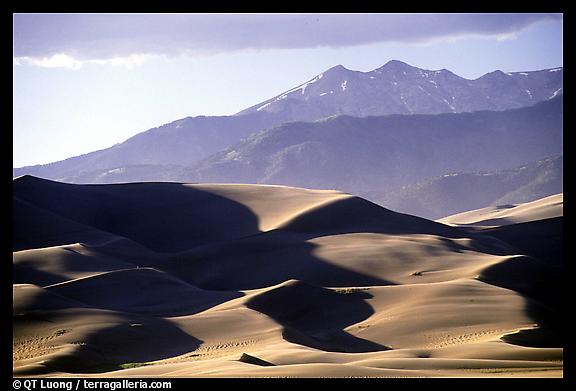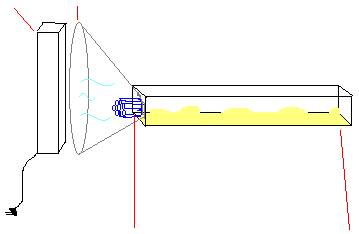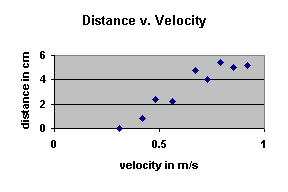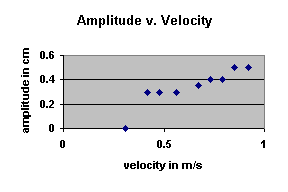
Sand Dunes
Examining how wind velocity affects the amplitude of and distance between waves in sand
by Heather Jacobson
According to the Columbia Electronic Encyclopedia, a dune defined in simple terms is a mound or ridge of wind-blown sand. However, even though sand dunes are common features around the world and easily observable, the physics of their behavior or movement is poorly understood (Pennicott, 2002). Something that we do know is that sand dunes come in two main kinds and four different forms. The two kinds of dunes are transverse and longitudinal. Transverse dunes form when the wind’s direction is consistent and have gentle windward slopes and steep lee sides, whereas longitudinal dunes have similar slopes on both sides and are elongated in the direction of the prevailing wind (“Dune”, 2004). The four major forms of sand dunes are crescentic, linear, star, and parabolic. Crescentic dunes are the first dune type to form. They occur transverse to the wind where sand is abundant and the wind blows from one main direction (Lancaster, 1996). Crescentic dunes are those relevant to this experiment because the set up will favor the forming of this type. Lancaster (1996) claims that the major influences on the form of a dune are the directional variability of the wind and the availability of sand. He says that wind speed and sand grain size play a smaller role. The purpose of this research project is to discover what the relationship is between the wind velocity and the spacing and height of sand dunes.
When wind blows across a desert it carries sand grains in a jumping motion called saltation (Siever, 1988). The wind speeds up when it encounters the incline of a dune, allowing it to carry even more sand (Pennicott, 2002). Also, the greater the velocity, the bigger the grains it can carry and the greater the volume of sand it can move (Siever, 1988). Siever argues that the size and spacing of dunes increases as the velocity does. This seems to be related to the average distance grains jump (“Sand Dunes”, 1999). My hypothesis is that the height and spacing between sand dunes will both increase as wind velocity increases because faster winds can carry more sand (leading to bigger dunes) and make grains go farther (leading to greater distance between dunes). The wind velocity will be the independent variable and the height and distance between the dunes will be the dependent variables. Height is defined as the amplitude of the sand dune at its crest (highest point) and spacing is defined as the distance between the crests of two dunes. Wind velocity is the speed of the wind measured in meters per second.
· sand (fine sand best)
· straws
· fan
· long rectangular box
· Elizabethan dog cone
· thread
· sticky tack
· timer
· ruler
· triple beam balance
· wire
· flashlight
fan Elizabethan collar

straws box with sand
Before setting up this experiment, it is important to make sure that the materials are going to work. For example, the sand needs to be fine grain, like craft sand or fine beach sand, so that it will respond the best to wind. Also, after preliminary testing, I realized that it is important for the box not to be too wide so that the wind can be concentrated in a smaller volume of space. After gathering the materials, the first thing to do was to construct the wind tunnel. When deciding how to construct the wind tunnel I was faced with my first dilemma. I needed to decide how the air would escape from the box: out the top or out the end of the box. If the top was open it would be easier to measure the sand dunes, but the air as it escaped might swirl around and disrupt the dunes. If the end was open then the air flow would remain straight, but there would be the possibility that sand would be blown out and it would also be harder to measure the dunes. I compromised by deciding to make the top removable and the end only partially open. Then I planned and constructed the rest of the tunnel. I realized that the air coming from the fan would probably be swirling around, but I needed it to be straight so that there would be as few variables affecting the formation of the dunes as possible. So, I taped together a bunch of straws (to ensure that the wind entering the box would be from one direction) and attached it to an opening I made at the bottom of the front end of the box. Then, to make as much air as possible go from the fan to the straws, I used an Elizabethan dog collar to connect the fan to the opening of the box. With the tunnel constructed, I poured sand into the box. Applying even pressure, I used a piece of cardboard to spread the sand out evenly. At this point, my experimental setup was complete.
For my first data point, I wanted to start with the greatest wind velocity and work my way down, so I placed the fan as close to the Elizabethan collar as I could. To measure the wind velocity, I constructed a pendulum of thread with a small (.1 gram) ball of sticky tack on the end. I hung the pendulum inside the box close to the straws, shone a light at the pendulum to create a shadow on the side, and marked where the ball of tack was. Then, I turned on the fan and marked the place to which the pendulum swung. I recorded this as the change in height. I then let the fan run for two hours in order for dunes to form (I chose this time after observing in a test run that dunes seem to reach their maximum height after two hours). After two hours, I stopped the fan and collected data points. I measured the distance between the first two dunes by holding a piece of wire above them and then measuring the length of the wire. I measured the height of the first dune by sticking the wire in the dune at its crest and marking the length. I chose to measure the distance and height with the first two dunes because they were the most defined. For my next set of data points, I moved the fan away from the Elizabethan collar a little bit to lower the wind speed. Then I repeated the data collection procedures for nine different wind velocities.
|
Change in height (Δh) |
Wind velocity (V= sqrt(2gΔh)) |
Distance between dune crests (in cm) |
Amplitude of dune (in cm) |
|
.5 cm |
.31 m/s |
No dunes |
No dunes |
|
.9 |
.42 |
.8 |
.3 |
|
1.2 |
.48 |
2.4 |
.3 |
|
1.6 |
.56 |
2.2 |
.3 |
|
2.3 |
.67 |
4.8 |
.35 |
|
2.7 |
.73 |
4.0 |
.4 |
|
3.2 |
.79 |
5.4 |
.4 |
|
3.7 |
.85 |
5.0 |
.5 |
|
4.3 |
.92 |
5.2 |
.5 |

The uncertainty for the distance and amplitude measurements was probably about one millimeter. This seems small, but could actually be significant because the measurements are so tiny to begin with. The uncertainty for the change in height was also about one millimeter.
My hypothesis that the amplitude and distance between sand dunes would increase as the wind velocity did was somewhat supported by the data I collected. For the amplitude, there was a clear trend where the height increased as the velocity did. It was interesting in the results how, with the velocity, a limit seemed to be approached under which the wind wasn’t strong enough to move the sand. Between the velocities of .31 and .42 m/s, there must be a critical point where the velocity can no longer overcome gravity’s force on the sand grains. Velocity’s effect on the distance between sand dunes was less predictable. For example, as the velocity increased the distance at one point went from .8 to 2.4 to 2.2 cm. Still, the overall trend was that the distance increased with the velocity, supporting the hypothesis. It is possible that the uncertainty could account for the measurements that did not support the trend.
There were several sources of error and uncertainty in this experiment that could have affected the results. I already mentioned the margin of error with the measurement; though small, the uncertainty could have a significant impact on the conclusions reached. In addition, a possible source of error within the procedures was the way the sand was prepared. I tried to keep the sand base at a consistent depth for each trial, but it is very possible that the sand level was different for some trials. A plausible solution to reduce the impact of the errors (if time permitted) would be to conduct more trials. The uncertainty could also be reduced if there was a better way to measure the results. Perhaps if the tunnel was made of a transparent material then the distance and amplitude could be measured more accurately from the side. Also, this experiment could be improved with the use of better equipment, in particular, a more powerful fan. The fan that I used was not powerful enough to form large dunes. With a stronger fan, the experiment could be expanded to see if the results are consistent for even greater velocities.
Several ideas for subsequent research have come up during this investigation. For example, it would be interesting to try to pinpoint the smallest velocity at which a dune would form. Besides wind velocity, it would be intriguing to look at grain size, amount of sand, and time’s effect on the formation of sand dunes, as well as compare their degree of impact. Another fun experiment (though largely based on guessing) would be to try to create the different dune shapes by varying the direction of the wind. There are many different ways in which this experiment could be continued.
“Dune.” The Columbia Electronic Encyclopedia 2004. 18 October 2004
<http://print.infoplease.com/ce6/sci/A0816336.html>.
I used this source to find a basic definition of what a sand dune is
Lancaster, Nicolas. “Geologic Work By Wind.” Macmillan
Encyclopedia of Earth
Sciences. Volume 1. New York: Simon and Schuster Macmillan, 1996.
This explains the major types of dunes and discusses what factors determine the shape of a dune
Pennicott, Katie. “Sand-dune science creeps ahead.” PhysicsWeb 18 December 2002.
9 October 2004 <http://physicsweb.org/articles/news/6/12/12/1>.
This site looks at the difficulties facing those who wish to study sand dunes
“Sand Dunes: A Phenomenon of Wind.” Wayne’s Word 1999. 9 October 2004
<http://waynesword.palomar.edu/ww0704.htm>.
Another source that discusses the formation of sand dunes
Siever, Raymond. Sand. New York: Scientific American Library, 1988.
An amazingly scientific book that has some interesting results from experiments manipulating sand dunes
U.S. Geological Survey: Types of Dunes
This site explains the shapes of dunes and has great pictures
This site has some great articles about sand dunes
 Data File:
Data File: